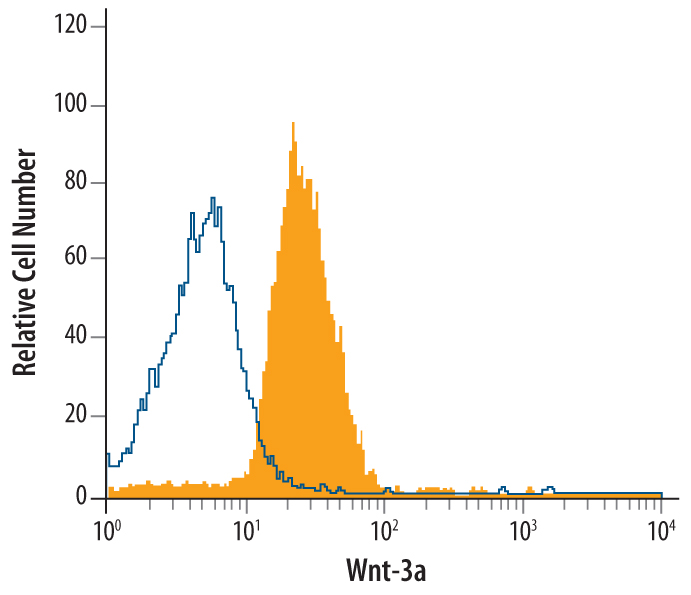Human/Mouse Wnt-3a Antibody Summary
Ser36-Gln75, Trp219-Arg269
Accession # P27467
Applications
Please Note: Optimal dilutions should be determined by each laboratory for each application. General Protocols are available in the Technical Information section on our website.
Scientific Data
 View Larger
View Larger
Detection of Mouse Wnt‑3a by Western Blot. Western blot shows lysates of CHO Chinese hamster ovary cell line either mock transfected or transfected with mouse Wnt-3a. PVDF membrane was probed with 1 µg/mL of Rat Anti-Human/Mouse Wnt-3a Monoclonal Antibody (Catalog # MAB13242) followed by HRP-conjugated Anti-Rat IgG Secondary Antibody (Catalog # HAF005). A specific band was detected for Wnt-3a at approximately 40 kDa (as indicated). This experiment was conducted under reducing conditions and using Immunoblot Buffer Group 1.
 View Larger
View Larger
Detection of Wnt3A in BG01V Human Stem Cells by Flow Cytometry. BGO1v human embryonic stem cells were stained with Rat Anti-Human/Mouse Wnt-3a Monoclonal Antibody (Catalog # MAB13242, filled histogram) or isotype control antibody (Catalog # MAB006, open histogram), followed by Allophycocyanin-conjugated Anti-Rat IgG Secondary Antibody (Catalog # F0113). To facilitate intracellular staining, cells were fixed and permeabilized with FlowX FoxP3/Transcription Factor Fixation & Permeabilization Buffer Kit (Catalog # FC012).
Reconstitution Calculator
Preparation and Storage
- 12 months from date of receipt, -20 to -70 °C as supplied.
- 1 month, 2 to 8 °C under sterile conditions after reconstitution.
- 6 months, -20 to -70 °C under sterile conditions after reconstitution.
Background: Wnt-3a
Wnt-3a is one of about 19 vertebrate members of the Wingless-type MMTV integration site (Wnt) family of highly conserved cysteine-rich secreted glycoproteins important for normal developmental processes (1‑3). Wnts bind to receptors of the Frizzled family in conjunction with a coreceptor of the low-density lipoprotein receptor-related protein family (LRP-5 or -6), or the Ryk atypical receptor tyrosine kinase (1, 4). Mouse Wnt-3a is a 44 kDa secreted hydrophobic glycoprotein containing a conserved pattern of 24 cysteine residues (5). Like other Wnts, Wnt-3a is modified by palmitate addition (at Cys 77) following glycosylation, which increases its hydrophobicity, secretion and activity (6, 7). A second site at Ser 209 is modified by palmitoleic acid and also contributes to activity and secretion (8). Mouse Wnt-3a shares 96% amino acid (aa) identity with human Wnt-3a, and 97% with bovine and canine Wnt-3a. The rat Wnt-3a precursor as it is apparently translated shares 100% aa identity with mouse Wnt-3a aa 63-352 (9). Wnt-3a also shares 87% aa identity with Wnt-3. During development, Wnt-3a is morphogen that is thought to coordinate somitogenesis and mesoderm boundary determination, and is expressed at the same locations and times as Wnt-2b and Wnt-5a (10). When Wnt-3a is deleted, mice fail to develop a hippocampus, and show defects in anterior-posterior patterning, somite development and tailbud formation (10-13). Recombinant Wnt-3a promotes proliferation of committed stem cell lineages in vitro, and may help maintain the cells in an undifferentiated state (6, 14) For example, Wnt-3a can induce self-renewal of hematopoietic stem cells, allowing expansion without further differentiation (6).
- Mikels, A.J. and R. Nusse (2006) Oncogene 25:7461.
- Miller, J.R. (2001) Genome Biol. 3:3001.
- Roelink, H. and R. Nusse (1991) Genes Dev. 5:381.
- Lu, W et al. (2004) Cell 119:97.
- Smolich, B.D. et al. (1993) Mol. Biol Cell 4:1267.
- Willert, K. et al. (2003) Nature 423:448.
- Komekado, H. et al. (2007) Genes Cells 12:521.
- Takada, R. et al. (2006) Dev. Cell 11:791.
- Entrez Accession # NP_001100475.
- Dunty, W.C. et al. (2008) Development 135:85.
- Lee, S.M.K. et al. (2000) Development 127:457.
- Takada, S. et al. (1994) Genes Dev. 8:174.
- Ikeya, M. and S. Takada (2001) Mech. Dev. 103:27.
- Nusse, R. (2008) Cell Res. 18:523.
Product Datasheets
Citations for Human/Mouse Wnt-3a Antibody
R&D Systems personnel manually curate a database that contains references using R&D Systems products. The data collected includes not only links to publications in PubMed, but also provides information about sample types, species, and experimental conditions.
2
Citations: Showing 1 - 2
Filter your results:
Filter by:
-
Sevoflurane induces inflammation of microglia in hippocampus of neonatal rats by inhibiting Wnt/&beta-Catenin/CaMKIV pathway
Authors: F Wang, C Li, J Shao, J Ma
Journal of pharmacological sciences, 2021-03-16;146(2):105-115.
Species: Rat
Sample Types: In Vivo
Applications: In Vivo -
Next-Generation Surrogate Wnts Support Organoid Growth and Deconvolute Frizzled Pleiotropy In�Vivo
Authors: Y Miao, A Ha, W de Lau, K Yuki, AJM Santos, C You, MH Geurts, J Puschhof, C Pleguezuel, WC Peng, R Senlice, C Piani, JW Buikema, OM Gbenedio, M Vallon, J Yuan, S de Haan, W Hemrika, K Rösch, LT Dang, D Baker, M Ott, P Depeille, SM Wu, J Drost, R Nusse, JP Roose, J Piehler, SF Boj, CY Janda, H Clevers, CJ Kuo, KC Garcia
Cell Stem Cell, 2020-08-19;0(0):.
Species: Human
Sample Types: Cell Lysates
Applications: Western Blot
FAQs
No product specific FAQs exist for this product, however you may
View all Antibody FAQsReviews for Human/Mouse Wnt-3a Antibody
There are currently no reviews for this product. Be the first to review Human/Mouse Wnt-3a Antibody and earn rewards!
Have you used Human/Mouse Wnt-3a Antibody?
Submit a review and receive an Amazon gift card.
$25/€18/£15/$25CAN/¥75 Yuan/¥2500 Yen for a review with an image
$10/€7/£6/$10 CAD/¥70 Yuan/¥1110 Yen for a review without an image





